First published in 1934, Mary Thomas’s Dictionary of Embroidery Stitches is a classic resource, instructional book, and stitch guide for embroiderers all over the world.
The book was a trailblazer in its time, and it’s gone through a few editions since then. The contemporary versions of the book are revised by Jan Eaton, with updated stitch diagrams and photos of the embroidery stitches worked on fabric.
Recently, the book has gone out of print, but fortunately for us, it was picked up again by Search Press in the UK and by Trafalgar Square Books in the US, bringing us a new edition of a great classic.
Since the new edition is due to be released at the end of this month, I thought I’d show it to you. If you don’t have a stitch dictionary yet to use as reference at home, this is one that I always recommend, because of its easy-to-navigate layout, easy to read diagrams and instructions, and logical categorization of stitches.
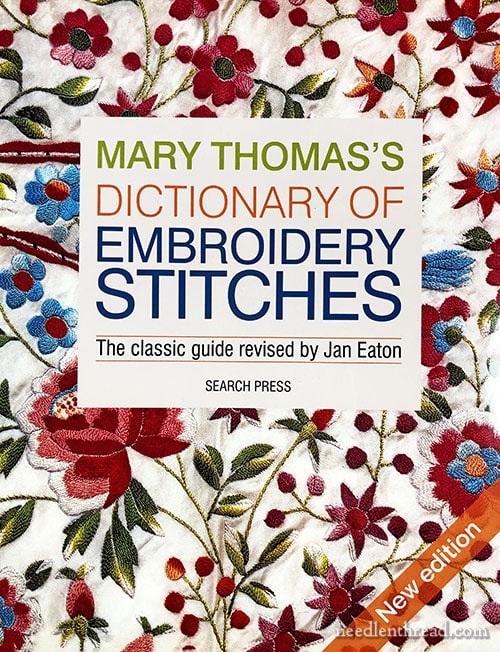
Like most new editions of a book, the cover is a little different, and, I think, very appealing for today’s embroidery aesthetic. In short, it’s pretty!
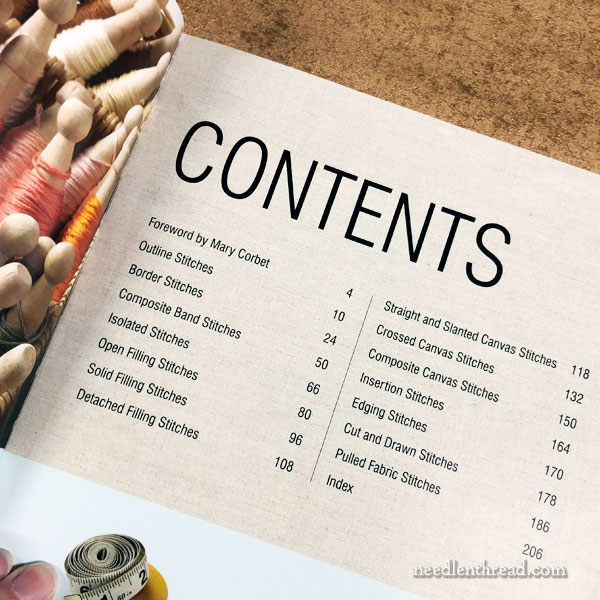
You can see by the contents that the 400+ stitches in the book are arranged by type.
This is such a helpful layout when you’re looking for specific kinds of stitches.
For example, imagine that you’re working a project and you decide you want to fill an area with a solid filling stitch. You can flip right from the table of contents to “solid filling stitches” and see those stitches in action to decide if any of them will work for what you have in mind.
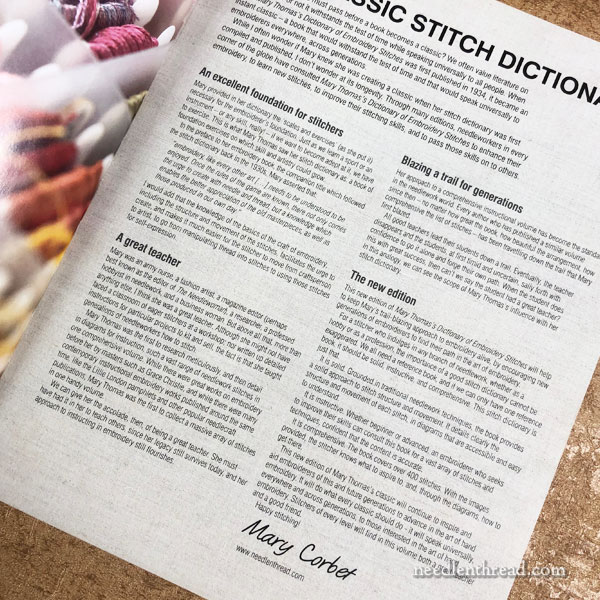
I was very honored to be asked to write the forward for this new edition, so you’ll find some words by me at the beginning of the book about Mary Thomas, her work, and this new edition.
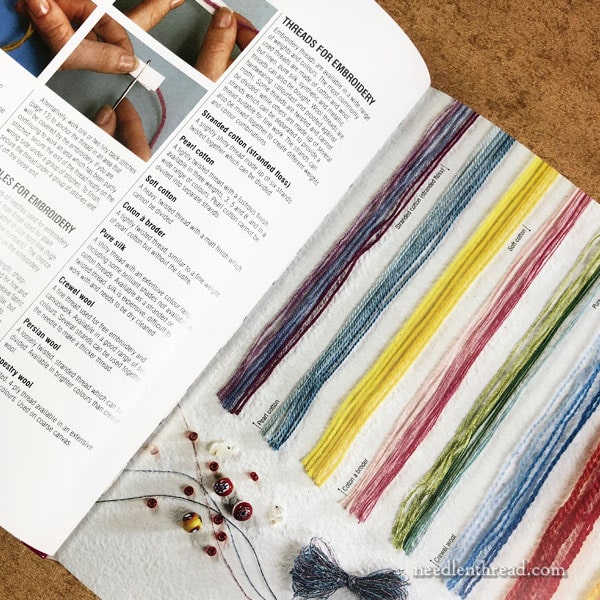
Before the stitch dictionary part of the book begins, you’ll find information on materials to use for embroidery, and some of the basics that will help anyone new to embroidery get started.
Putting aside all the advances that have been made in publishing and photography since the early 1900’s, the materials used in embroidery is another good reason that necessitates new editions of books like Mary Thomas’s Dictionary of Embroidery Stitches.
While there are many materials used in embroidery today that were also used in the early 1900’s, some materials are no longer available, and, of course, there are many new materials that weren’t available then.
So it makes sense to update these older books with contemporary information!
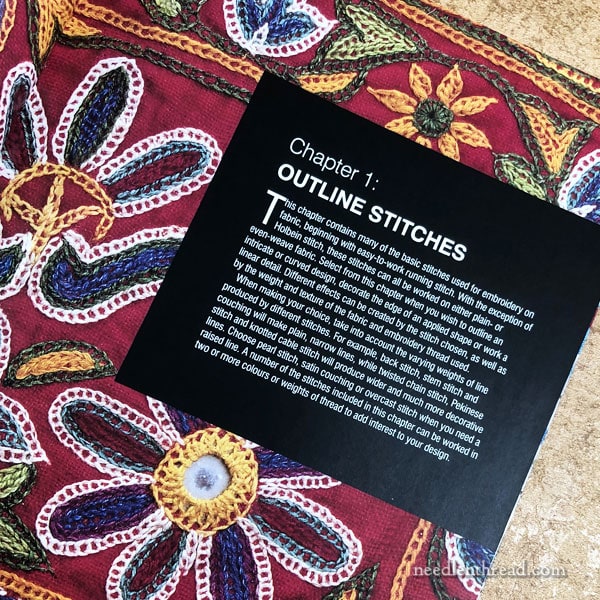
Each section of the book begins with a colorful title page, introducing the types of stitches in that section.
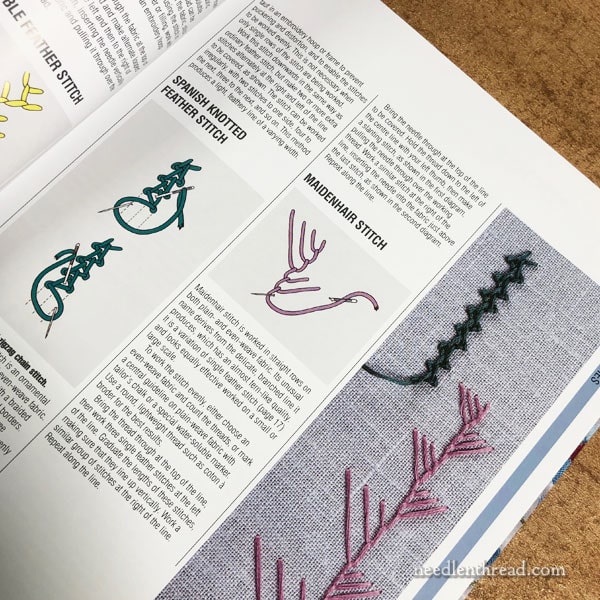
The stitches are presented in easy-to-follow diagrams and instructional text.
You’ll also find photos of the stitches worked out, so that you can see what they look like when they are stitched.
The book covers over 400 stitches in the following categories:
- Outline Stitches
- Border Stitches
- Composite Band Stitches
- Isolated Stitches
- Open Filling Stitches
- Detached Filling Stitches
- Straight and Slanted Canvas Stitches
- Crossed Canvas Stitches
- Composite Canvas Stitches
- Insertion Stitches
- Cut and Drawn Stitches
- Pulled Fabric Stitches
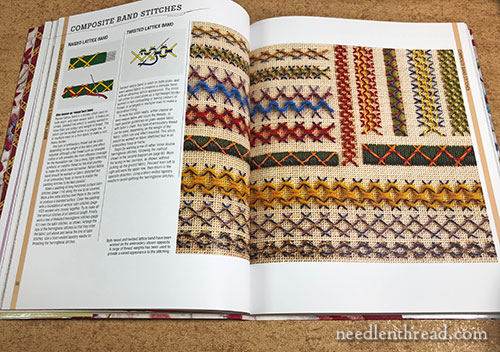
This 2019 edition of Mary Thomas’s Dictionary of Embroidery Stitches features what I call (and I’m sure it’s not the technical term for it!) a “floppy binding.” That is, the book will lie open on its own. It isn’t a floppy book, but the binding allows it to remain open without any assistance.
This is a nice feature, when you’re stitching from the book!
Where to Find It
If you don’t have Mary Thomas’s Dictionary of Embroidery Stitches on your bookshelf, now’s a good time to put it there! It will surely become one of your favorite reference books!
You’ll find the book available here on my Amazon Recommendations page.
And here’s a direct link to the listing on Amazon.
Worldwide, with free shipping, you’ll find the book available here through Book Depository.
This article contains affiliate links to book sources. This means that Needle ‘n Thread receives a small commission for purchases made through those links, with no extra cost to you. Every penny helps! Thanks!







So, I have the reprinted edition. Is there enough of a change/improvement in the new edition to make a purchase important?
Thanks!
Hi, Jan – Not really. I like the binding better on the new edition, but the instructional content on the stitches (diagrams, etc.) is the same.
Hello Mary,
Just for information for your UK readers; Hodder & Stoughton published a Jan Eaton revised hard-backed edition of Mary Thomas’s book in 1989 in the UK, with a second impression in 1991 of which I have a copy. Having ‘looked inside’ on Amazon UK – other than your forward, Mary – the new edition looks identical to that publication even down to page numbers. So if UK stitchers have that copy, they could forgo your very enthusiastic and interesting forward, and save the disappointment of parting with £23 for a book which is probably so well used that it stays open of its own accord!
Incidentally, I have two copies of the original Mary Thomas’s Dictionary of Embroidery Stitches both of which belonged to my mother. The first, published in 1941, has a spine one and three quarter inches wide and the second, 1948, is just an inch wide. The only difference is the thickness/quality of the paper on which they’re printed due to the intervention of WWII.
Regards,
JoyceR.
Thanks, Joyce! Good information to know! I have the original editions of Mary Thomas’s Dictionary and her Embroidery Book. They are rather thick, but you know, I like their size. They’re comfortable, somewhat chunky books!
Thank you, Mary. It will be my first own embroidery book. No, not the first – first was the “Enzyklopädie der weiblichen Handarbeiten” by Dillmont, but this one wasn’t very helpful as yet. Mary Thomas’ book surely will. Just ordered it through Book Depository (I’m so excited that they offer free shipping worldwide!), because I’m not in the US, but I’ve klicked on your amazon recommendations page as well and hope you’ll get a small reward anyway (if I got you right).
Hope your Mum’s health keeps improving! Best wishes, Angela from the Ore Mountains
Hi, Angela – Thanks for that! Actually, it doesn’t make any difference if you click the Amazon link. They offer commissions only for sales. But that’s not a problem! It’s just there if people want to use it. Mom is improving. She’s home now, so the work schedule is in constant flux, needless to say!
I think it’s so fitting and wonderful that you wrote the Introduction to this new edition and I’m so glad this excellent stitch dictionary is being published again – I hope it never goes out of print! I bought a copy of the last edition from your recommendation posts about stitch dictionaries when I was starting to get into hand embroidery a few years ago, and it is a delight to use and very informative. I’ve only scratched the surface of it so far but I’m hoping to learn more of the many stitches in it this year 🙂
Thanks for the heads up about the new book. I have a 1936 copy of her embroidery book! I’m sure I have other copies of her books floating around as well but I need a librarian to organize them all for me! LOL!
As an Amazon seller, I noticed something wrong with the listing that your link goes to. You might want to warn your readers that people have used the listing to list other Mary Thomas books as some are listed with prior owner names instead and other indications that the book is used, besides actually using the word ‘used’. You can’t even be sure unless you are buying directly from Amazon, that you will get this newest book when it is described as new. Potential buyers can send a question to sellers to ask if this is the new 2019 book. Of course, a negative response means they probably don’t want to buy it from them. The used copies are why some are listed at half the pre-publication price.
Hope this helps prevent some confusion. Even the photo of the book changes within the listing to the older book.
Hi, Gail – Thanks for the heads up! Actually, my link goes directly to my Amazon page, where they can click on the book. That link takes them directly to the pre-order for the new book. Only if they click on the other offerings (which every Amazon product has, if third party sellers sell the same thing), will they end up away from the pre-order for the new edition. Hope that helps.
I have ISBN 1-57076-118-3
Mary Thomas’s Dictionary of Embroidery Stitches Revised, full-color edition of this classic book, with over 100 new stitches
New Edition by Jan Eaton
First paperback edition published in the United States of America 1998 by Trafalgar Square Publishing, North Pomfret, Vermont 05053
Printed at: Oriental Press Dubai U.A.E.
From the sample photos you’ve posted they appear the same — do you know if there have been new stitches added since my edition? how many? or is it the same book just back in print with a new binding?
Thanks :o)
Hi, Krista – If you already have the Jan Eaton book, you don’t need the new edition – the stitches are the same. The binding, cover, and some text on the inside, but all the essentials are the same.
Dear Mary
Mary Thomas’s Dictionary of Embroidery Stitches looks a very useful and interesting book to own especially considering when it was first published, it’s also great that you wrote the introduction to it. Thanks for sharing the book with us and the links where to purchase it. I’m glad that your mum is at out of ICU and at home I’m sure that is a great relief to you and all the family.
Regards Anita Simmance
I have 2 versions of this book. One is black and white and the other is in color and very nice. I’m glad to see it again. Thanks for showing how the book has been up dated.
It certainly is a beautiful book. Thanks for all of your recommendations.
What amazing timing! I tripped over this post while searching for a preprinted sampler on instagram using a Japanese (I think?) translation as the stitch reference. Do you know of anywhere in the US to get this fabric? The only source I could find was in Japan as part of a certification course for teachers.
Hi, Lorena – I’m not quite sure what fabric you mean?
Oh oops! The link I posted must have gotten stripped out. I first saw the fabric in the most recent post from instagram user @nana_embroidery_works and I clicked around on tags until I found someone who posted more info. The fabric is sort of a preprinted sampler grid offered along with a translation of the book as part of an “Embroidery stitch communication course” through a Japanese professional development page called aalwshop.
Hi Mary, is the version of Mary Thomas’s “Dictionary of Embroidery Stitches” book that you wrote about the hard bound version or the paperback? You mentioned that it lays flat.
Also, I love your blog. You are an amazing stitcher!
The new edition is the one shown in the photos above. It is a stiff-ish cover, slightly bendable in a way, but due to the binding, it lies flat.
First off, I love your website. It’s got everything!
I draw my own designs on fabric. What I’d like to find is a very fine pen to draw on the fabric — one which doesn’t
‘bleed’ on the the fabric. Any ideas where I can find one? Or, I’m open to new ideas about drawing on my fabric. Something erasable would be nice…??
Help! Thanks, Greear
The problem with something erasable is that erasing can really mess up the surface of some fabrics. Fabric just doesn’t erase the same way paper does! The micron art pens are nice for getting a really really fine line (the 005), but they are pretty much permanent. I always set mine with an iron after tracing with those, because it could feasible run if the fabric gets wet. They aren’t guaranteed permanent on fabric. I’ve not had problems with them, but I know some people who have.
Hi Mary
Thank you for this excellent review. I have put the book in my cart at Amazon, but I am waiting to order because I wanted to tell you that your affiliate link is not working, & the book is not in your list of books in your larger affiliate link. I would like for you to get your $ because I loved your reviews. If you can repair the link, I’d be more than happy to wait.
Thanks,
Lynne
Hi, Lynne – Thanks for noticing that! I repaired the link, and I also moved the book up on my “Amazon Recommendations” list on by Amazon page, so it’s near the top of the list. 🙂